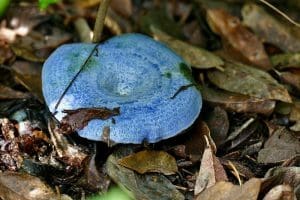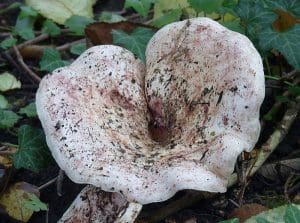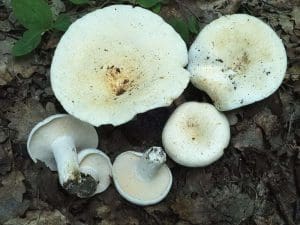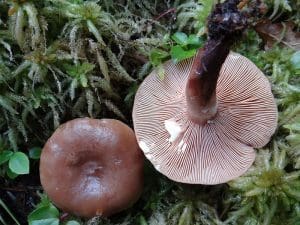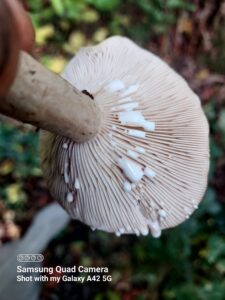Through this guide we’re going to take a look at the milkcap mushrooms, how to identify the family in general as well as some of the most common ones we’ll find when out foraging. We’ll also be looking at some of our absolute favourite milkcaps for eating and adding to the fungi cooking put!
Milkcaps
The Milkcap mushrooms or Lactarius is the most common mushroom family in the UK with around 70 species native to these shores. They are closely related to the brittlegiils and get their common name because they leak ‘milk’ or latex when they are damaged. The milk or latex is often white or cream, but is more vividly coloured in some species, the milk can change colour when exposed to oxygen or remain unchanged.
The liquid is used as a defence mechanism against insect attacks and is a key feature when it comes to identification.
Other features to look for are:
- They are all mycorrhizal (growing with tree species so in woodlands or at least close to a tree)
- They have brittle flesh
- Many have concentric circular bands on the caps
- They are all gilled
- The stems lack a veil or skirt
- The caps are often depressed or even funnel-shaped with decurrent gills
- They all produce milk
Identifying a member of the family can therefore be quite easy but trying to pinpoint the exact species can sometimes be trickier.
Important features for identification of milk-caps are: initial colour of the latex and colour change, texture of cap surface, taste (mild, peppery, or bitter) of latex and flesh, odour, and microscopical features of the spores and the cap cuticle. The habitat and especially the type of host tree can also be critical.
There are a few gourmet milkcaps for example for the Saffron Milkcap, there are a few that can be dried and used as a spice, the Curry Milkcap for example but most are either too spicy or too bitter to eat rather than being toxic. They are no deadly poisonous members of this family!
The general rule of thumb for Milkcaps is to taste a small amount of the milk, if it is mild, sweet or mushroomy in flavour it is edible. If the milk is spicy or acrid, avoid it.
The Milkcap to be wary of:
The exception to this rule is the Fenugreek milkcap, which tastes quite nice but will upset your stomach if eaten in any great quantity.
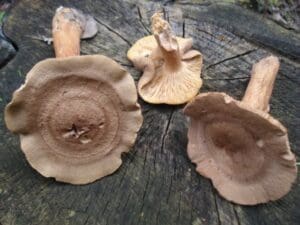
The Fenugreek milkcap is a fairly easy mushroom to ID. They smell like curry powder or fenugreek and when damaged they exude clear latex. It is the only UK Milkcap with completely clear latex, there are a few look-a-likes but their latex, though clear is still a bit milky. They are mildly toxic causing nausea and vomiting accompanied by vertigo and chills but are dried and used as a spice across most of Eastern Europe.
Cooking with milkcap mushrooms
In parts of Eastern Europe many of the spicier milkcaps are parboiled and packed in salt as a means of preserving them and improving their flavour. This process does improve the flavour but it’s not something we generally do in the UK.
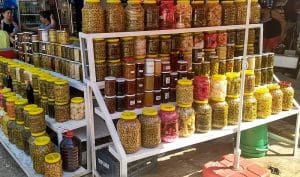
Here’s a really nicely polish pickled milkcap recipe from hunter angler gardner cook
The other edible ones (after doing the edibility test) I often chuck into my general mixed mushroom cooking pan and are a great addition to any recipe calling for edible mushrooms, apposed to those recipes calling for toxic mushrooms haha!
Common Milkcap mushrooms we find:
Here are some of the more common brilliant species:
Saffron Milkcap
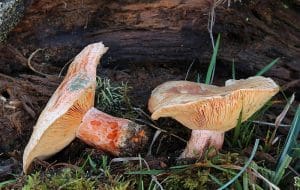
The Saffron Milkcap mushroom is one of the most exciting and easiest wild mushrooms to forage, when damaged it produces a vibrant orange latex-like liquid and is a great edible. To give you an idea of how highly they’re regarded it’s scientific name is Lactarius deliciosus! Enough said.
This choice edible mushroom, is medium to large, orange and funnel-shaped. They have brown concentric circles on the top of the cap with occasional green spotting. The stem is orange with darker orange spots or pitting and like the other milkcaps exudes a milky latex when cut or damaged. The milk of the Saffron Milkcap starts carrot orange and then turns swampy green. There are only 6 mushrooms in the UK that leak orange latex and they are all edible so you can’t really go too far wrong. The most likely thing you’ll confuse it for would be the mushroom below, it’s close relative the False Saffron Milkcap. But perhaps don’t eat them in excess as high consumption may cause your urine to go orange or red.
False Saffron Milkcap
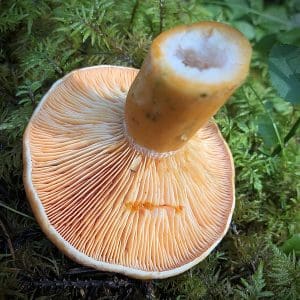
The False Saffron Milkcap Mushroom is the main thing that is often confused with the Saffron Milkcap, but not to worry though, it’s also edible
Lactarius deterrimus is a large milkcap with carrot-coloured gills and greenish tints as it matures. A distinctive feature is the latex ‘milk’ it exudes will change from carrot-orange to dark red then to green as it dries.
Oakbug Milkcap
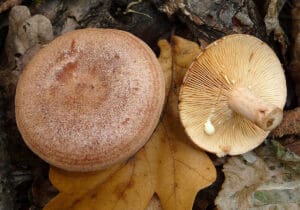
This is one of the most common milkcaps found in the UK and and is like the majority of the family in that whilst it not classed as toxic, it taste pretty awful!
As the name suggest you’ll find them in and around Oak tree’s, the bug part of its names refers to the smell, which is said to be similar to the smell of bedbugs. I have no idea what bedbugs smell like I so didn’t find this feature useful, to me they smell a little like oil, not cooking oil but the kind you’d use to fix a squeaky wheel or hinge.
It’s an easy mushroom to miss as they’re quite small, but once you spot one you’ll probably find many more. The caps are a reddish-brown colour with faint darker concentric rings. Another key feature is that in all but the wettest weather the caps have a dry, dull, matt finish. The milk tastes OK initially but gets more and more bitter with time and as I said earlier they taste pretty horrid.
Some to avoid!
Ugly Milkcap (Lactatius Turpis)
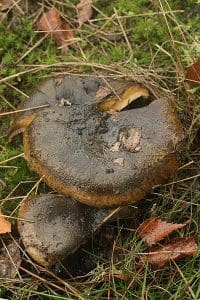
I know in this day and age we probably shouldn’t call people or things ugly but I really can’t think of a better name for this mushroom to be honest.
The caps are olive-brown in colour, the surface is sticky or slimy giving the appearance of being covered in black-green slime. Leaves and debris stick to this surface adding to the general ‘Ugly’ look. The latex from this species is hot, acrid and bitter and if all that’s not enough to put you off they contain the mutagen necatorin, which makes them carcinogenic. Again in parts of Russia they are considered a good edible species, but I would definitely not recommend eating them.
Woolly milkcap (Lactarius torminosus)
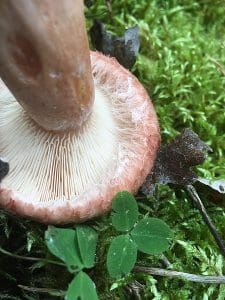
Although it is unlikely to cause death or long-term illness, this poisonous species, which looks like a smaller version of the equally toxic Bearded Milkcap (Lactarius Pubescens)
If eaten without very careful preparation, it can cause very unpleasant stomach upsets. Again in some parts of the world they are salted and then pickled, but many authorities do say that it should be treated as poisonous.
Conclusion
I really hope this quick milkcap guide has helped build up your understanding of the family and how to go about safely identifying them in the future. It’s quite an easy family to ID but sometimes getting down to an exact species is frustrating. I generally tell people to focus on the orange milking species, they’re the easiest to ID and the best for eating in my opinion.



